An Analysis of Specific Needs in Health and Social Care: A Report
VerifiedAdded on 2020/01/28
|14
|4547
|204
Report
AI Summary
This report delves into the crucial aspects of health and social care, emphasizing the specific needs of service users. It begins by defining key terms like health, disability, illness, and behavior, referencing the World Health Organization's definitions. The report examines the impact of these concepts within the health and social care sector, including legislative frameworks such as the Equality Act 2010 and the Disability Discrimination Act 1995. It uses the example of Macmillan Cancer Support to discuss approaches and intervention techniques for breast cancer, including primary and secondary prevention, diagnosis, and treatment options. Strengths and weaknesses of these interventions are analyzed, along with the use of technology in cancer detection and treatment, such as bioelectric imaging and computer-aided detection. The report also considers the impact of technology on people and services provided for individuals.
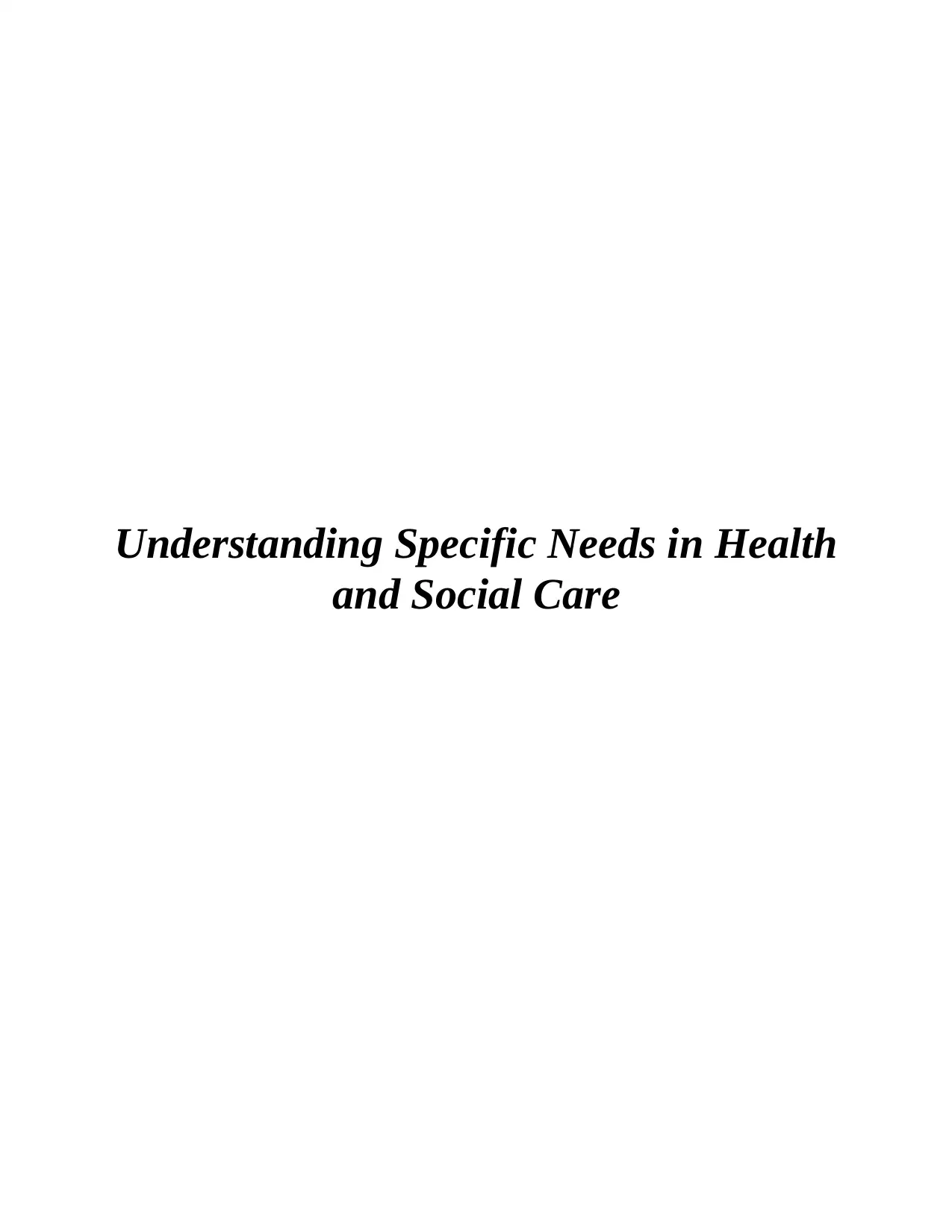
Understanding Specific Needs in Health
and Social Care
and Social Care
Paraphrase This Document
Need a fresh take? Get an instant paraphrase of this document with our AI Paraphraser
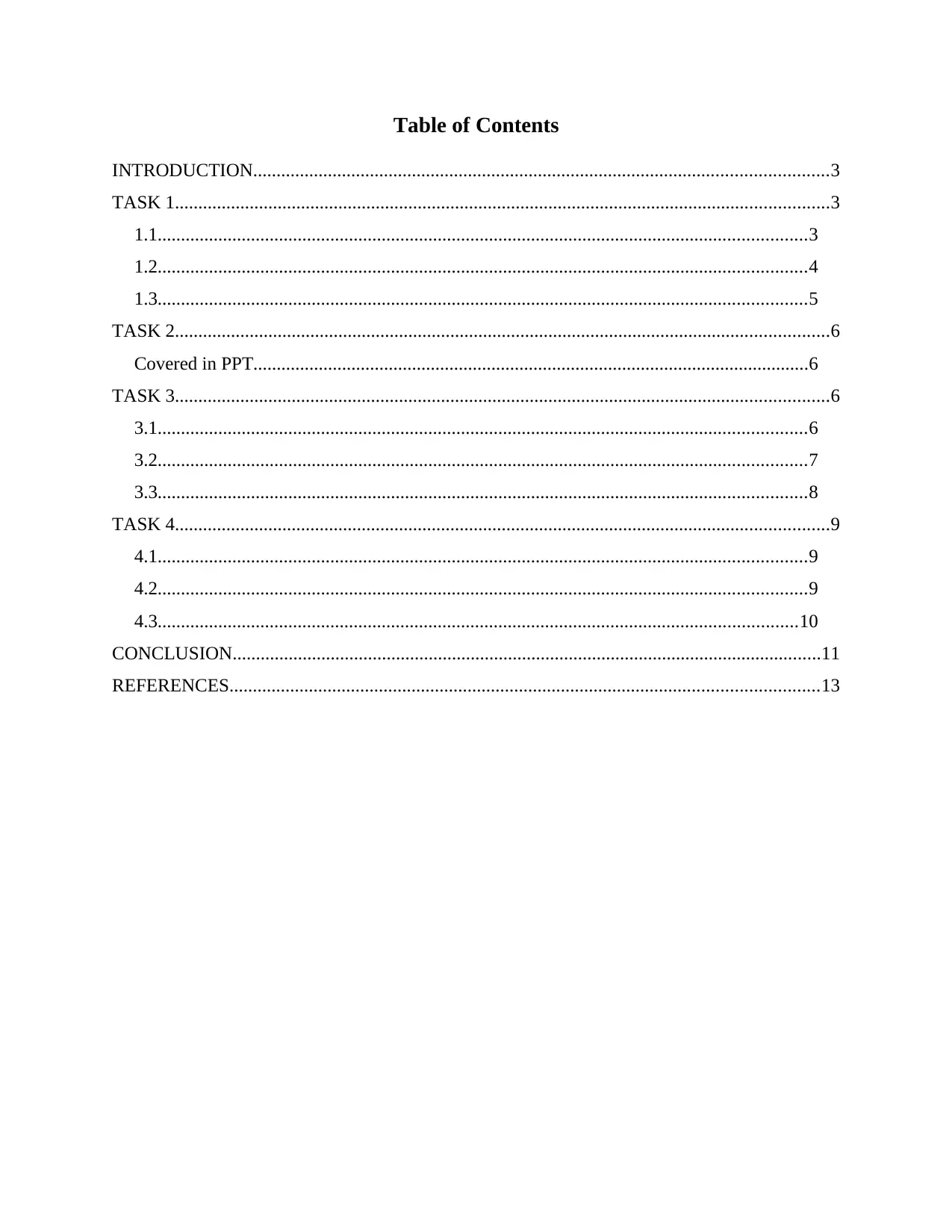
Table of Contents
INTRODUCTION...........................................................................................................................3
TASK 1............................................................................................................................................3
1.1...........................................................................................................................................3
1.2...........................................................................................................................................4
1.3...........................................................................................................................................5
TASK 2............................................................................................................................................6
Covered in PPT.......................................................................................................................6
TASK 3............................................................................................................................................6
3.1...........................................................................................................................................6
3.2...........................................................................................................................................7
3.3...........................................................................................................................................8
TASK 4............................................................................................................................................9
4.1...........................................................................................................................................9
4.2...........................................................................................................................................9
4.3.........................................................................................................................................10
CONCLUSION..............................................................................................................................11
REFERENCES..............................................................................................................................13
INTRODUCTION...........................................................................................................................3
TASK 1............................................................................................................................................3
1.1...........................................................................................................................................3
1.2...........................................................................................................................................4
1.3...........................................................................................................................................5
TASK 2............................................................................................................................................6
Covered in PPT.......................................................................................................................6
TASK 3............................................................................................................................................6
3.1...........................................................................................................................................6
3.2...........................................................................................................................................7
3.3...........................................................................................................................................8
TASK 4............................................................................................................................................9
4.1...........................................................................................................................................9
4.2...........................................................................................................................................9
4.3.........................................................................................................................................10
CONCLUSION..............................................................................................................................11
REFERENCES..............................................................................................................................13
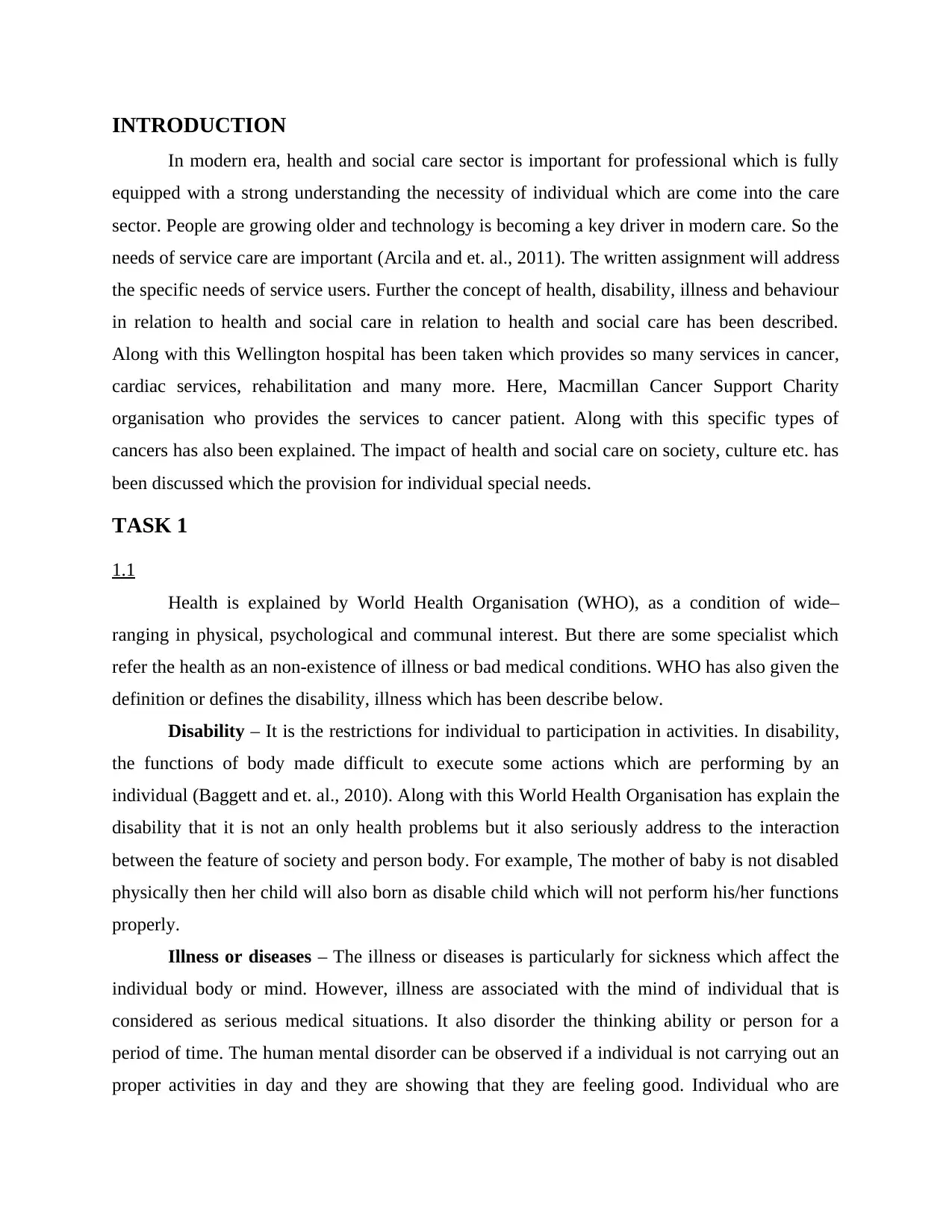
INTRODUCTION
In modern era, health and social care sector is important for professional which is fully
equipped with a strong understanding the necessity of individual which are come into the care
sector. People are growing older and technology is becoming a key driver in modern care. So the
needs of service care are important (Arcila and et. al., 2011). The written assignment will address
the specific needs of service users. Further the concept of health, disability, illness and behaviour
in relation to health and social care in relation to health and social care has been described.
Along with this Wellington hospital has been taken which provides so many services in cancer,
cardiac services, rehabilitation and many more. Here, Macmillan Cancer Support Charity
organisation who provides the services to cancer patient. Along with this specific types of
cancers has also been explained. The impact of health and social care on society, culture etc. has
been discussed which the provision for individual special needs.
TASK 1
1.1
Health is explained by World Health Organisation (WHO), as a condition of wide–
ranging in physical, psychological and communal interest. But there are some specialist which
refer the health as an non-existence of illness or bad medical conditions. WHO has also given the
definition or defines the disability, illness which has been describe below.
Disability – It is the restrictions for individual to participation in activities. In disability,
the functions of body made difficult to execute some actions which are performing by an
individual (Baggett and et. al., 2010). Along with this World Health Organisation has explain the
disability that it is not an only health problems but it also seriously address to the interaction
between the feature of society and person body. For example, The mother of baby is not disabled
physically then her child will also born as disable child which will not perform his/her functions
properly.
Illness or diseases – The illness or diseases is particularly for sickness which affect the
individual body or mind. However, illness are associated with the mind of individual that is
considered as serious medical situations. It also disorder the thinking ability or person for a
period of time. The human mental disorder can be observed if a individual is not carrying out an
proper activities in day and they are showing that they are feeling good. Individual who are
In modern era, health and social care sector is important for professional which is fully
equipped with a strong understanding the necessity of individual which are come into the care
sector. People are growing older and technology is becoming a key driver in modern care. So the
needs of service care are important (Arcila and et. al., 2011). The written assignment will address
the specific needs of service users. Further the concept of health, disability, illness and behaviour
in relation to health and social care in relation to health and social care has been described.
Along with this Wellington hospital has been taken which provides so many services in cancer,
cardiac services, rehabilitation and many more. Here, Macmillan Cancer Support Charity
organisation who provides the services to cancer patient. Along with this specific types of
cancers has also been explained. The impact of health and social care on society, culture etc. has
been discussed which the provision for individual special needs.
TASK 1
1.1
Health is explained by World Health Organisation (WHO), as a condition of wide–
ranging in physical, psychological and communal interest. But there are some specialist which
refer the health as an non-existence of illness or bad medical conditions. WHO has also given the
definition or defines the disability, illness which has been describe below.
Disability – It is the restrictions for individual to participation in activities. In disability,
the functions of body made difficult to execute some actions which are performing by an
individual (Baggett and et. al., 2010). Along with this World Health Organisation has explain the
disability that it is not an only health problems but it also seriously address to the interaction
between the feature of society and person body. For example, The mother of baby is not disabled
physically then her child will also born as disable child which will not perform his/her functions
properly.
Illness or diseases – The illness or diseases is particularly for sickness which affect the
individual body or mind. However, illness are associated with the mind of individual that is
considered as serious medical situations. It also disorder the thinking ability or person for a
period of time. The human mental disorder can be observed if a individual is not carrying out an
proper activities in day and they are showing that they are feeling good. Individual who are
⊘ This is a preview!⊘
Do you want full access?
Subscribe today to unlock all pages.

Trusted by 1+ million students worldwide
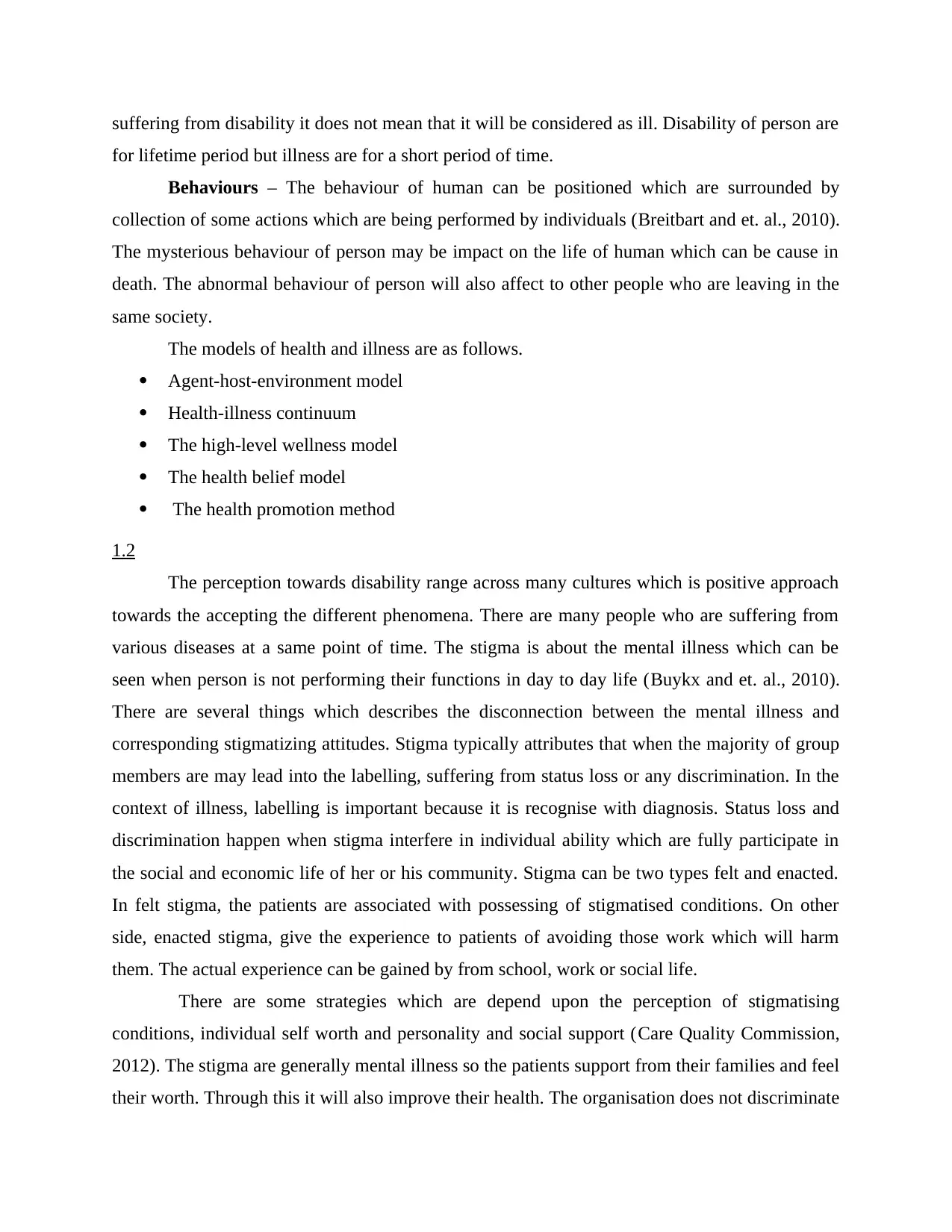
suffering from disability it does not mean that it will be considered as ill. Disability of person are
for lifetime period but illness are for a short period of time.
Behaviours – The behaviour of human can be positioned which are surrounded by
collection of some actions which are being performed by individuals (Breitbart and et. al., 2010).
The mysterious behaviour of person may be impact on the life of human which can be cause in
death. The abnormal behaviour of person will also affect to other people who are leaving in the
same society.
The models of health and illness are as follows.
Agent-host-environment model
Health-illness continuum
The high-level wellness model
The health belief model
The health promotion method
1.2
The perception towards disability range across many cultures which is positive approach
towards the accepting the different phenomena. There are many people who are suffering from
various diseases at a same point of time. The stigma is about the mental illness which can be
seen when person is not performing their functions in day to day life (Buykx and et. al., 2010).
There are several things which describes the disconnection between the mental illness and
corresponding stigmatizing attitudes. Stigma typically attributes that when the majority of group
members are may lead into the labelling, suffering from status loss or any discrimination. In the
context of illness, labelling is important because it is recognise with diagnosis. Status loss and
discrimination happen when stigma interfere in individual ability which are fully participate in
the social and economic life of her or his community. Stigma can be two types felt and enacted.
In felt stigma, the patients are associated with possessing of stigmatised conditions. On other
side, enacted stigma, give the experience to patients of avoiding those work which will harm
them. The actual experience can be gained by from school, work or social life.
There are some strategies which are depend upon the perception of stigmatising
conditions, individual self worth and personality and social support (Care Quality Commission,
2012). The stigma are generally mental illness so the patients support from their families and feel
their worth. Through this it will also improve their health. The organisation does not discriminate
for lifetime period but illness are for a short period of time.
Behaviours – The behaviour of human can be positioned which are surrounded by
collection of some actions which are being performed by individuals (Breitbart and et. al., 2010).
The mysterious behaviour of person may be impact on the life of human which can be cause in
death. The abnormal behaviour of person will also affect to other people who are leaving in the
same society.
The models of health and illness are as follows.
Agent-host-environment model
Health-illness continuum
The high-level wellness model
The health belief model
The health promotion method
1.2
The perception towards disability range across many cultures which is positive approach
towards the accepting the different phenomena. There are many people who are suffering from
various diseases at a same point of time. The stigma is about the mental illness which can be
seen when person is not performing their functions in day to day life (Buykx and et. al., 2010).
There are several things which describes the disconnection between the mental illness and
corresponding stigmatizing attitudes. Stigma typically attributes that when the majority of group
members are may lead into the labelling, suffering from status loss or any discrimination. In the
context of illness, labelling is important because it is recognise with diagnosis. Status loss and
discrimination happen when stigma interfere in individual ability which are fully participate in
the social and economic life of her or his community. Stigma can be two types felt and enacted.
In felt stigma, the patients are associated with possessing of stigmatised conditions. On other
side, enacted stigma, give the experience to patients of avoiding those work which will harm
them. The actual experience can be gained by from school, work or social life.
There are some strategies which are depend upon the perception of stigmatising
conditions, individual self worth and personality and social support (Care Quality Commission,
2012). The stigma are generally mental illness so the patients support from their families and feel
their worth. Through this it will also improve their health. The organisation does not discriminate
Paraphrase This Document
Need a fresh take? Get an instant paraphrase of this document with our AI Paraphraser
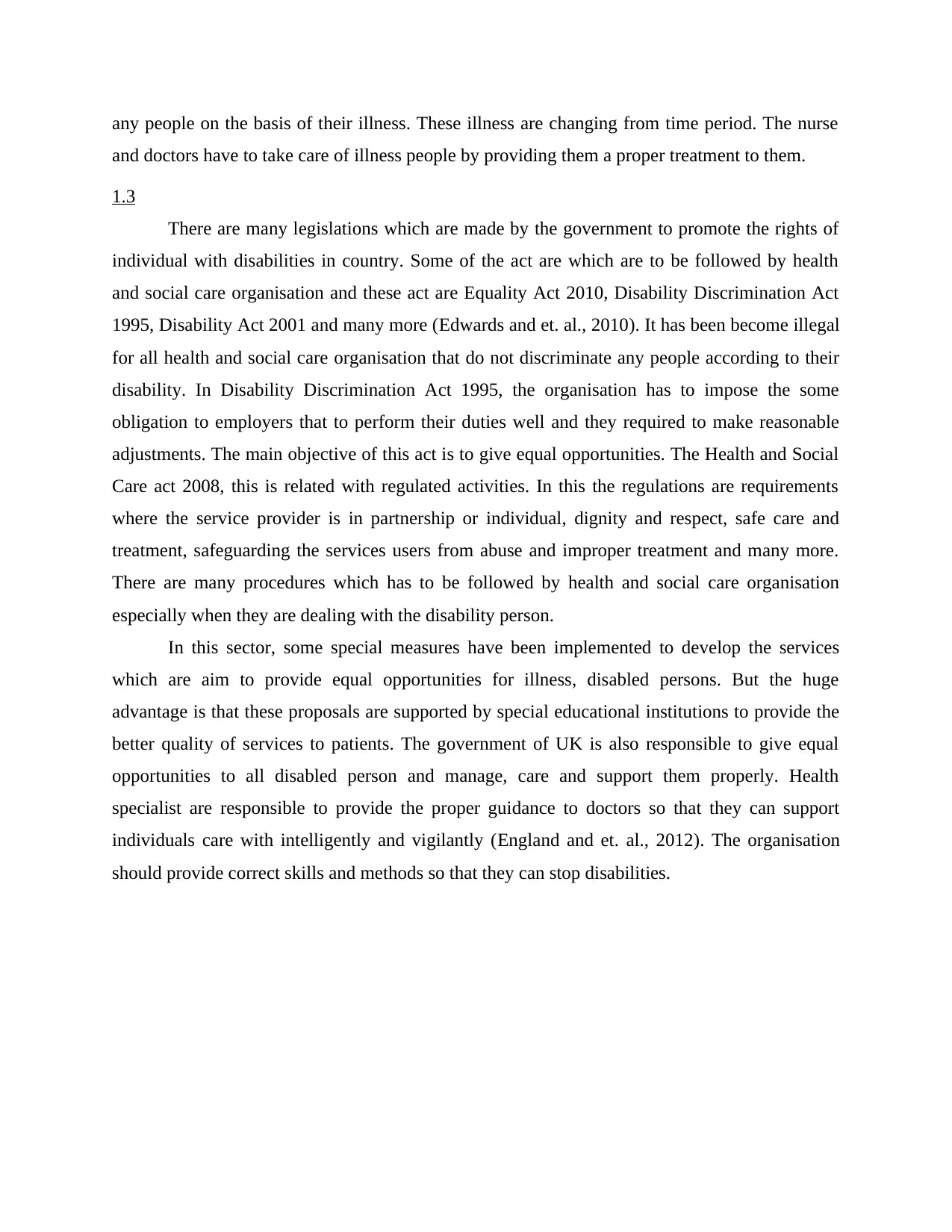
any people on the basis of their illness. These illness are changing from time period. The nurse
and doctors have to take care of illness people by providing them a proper treatment to them.
1.3
There are many legislations which are made by the government to promote the rights of
individual with disabilities in country. Some of the act are which are to be followed by health
and social care organisation and these act are Equality Act 2010, Disability Discrimination Act
1995, Disability Act 2001 and many more (Edwards and et. al., 2010). It has been become illegal
for all health and social care organisation that do not discriminate any people according to their
disability. In Disability Discrimination Act 1995, the organisation has to impose the some
obligation to employers that to perform their duties well and they required to make reasonable
adjustments. The main objective of this act is to give equal opportunities. The Health and Social
Care act 2008, this is related with regulated activities. In this the regulations are requirements
where the service provider is in partnership or individual, dignity and respect, safe care and
treatment, safeguarding the services users from abuse and improper treatment and many more.
There are many procedures which has to be followed by health and social care organisation
especially when they are dealing with the disability person.
In this sector, some special measures have been implemented to develop the services
which are aim to provide equal opportunities for illness, disabled persons. But the huge
advantage is that these proposals are supported by special educational institutions to provide the
better quality of services to patients. The government of UK is also responsible to give equal
opportunities to all disabled person and manage, care and support them properly. Health
specialist are responsible to provide the proper guidance to doctors so that they can support
individuals care with intelligently and vigilantly (England and et. al., 2012). The organisation
should provide correct skills and methods so that they can stop disabilities.
and doctors have to take care of illness people by providing them a proper treatment to them.
1.3
There are many legislations which are made by the government to promote the rights of
individual with disabilities in country. Some of the act are which are to be followed by health
and social care organisation and these act are Equality Act 2010, Disability Discrimination Act
1995, Disability Act 2001 and many more (Edwards and et. al., 2010). It has been become illegal
for all health and social care organisation that do not discriminate any people according to their
disability. In Disability Discrimination Act 1995, the organisation has to impose the some
obligation to employers that to perform their duties well and they required to make reasonable
adjustments. The main objective of this act is to give equal opportunities. The Health and Social
Care act 2008, this is related with regulated activities. In this the regulations are requirements
where the service provider is in partnership or individual, dignity and respect, safe care and
treatment, safeguarding the services users from abuse and improper treatment and many more.
There are many procedures which has to be followed by health and social care organisation
especially when they are dealing with the disability person.
In this sector, some special measures have been implemented to develop the services
which are aim to provide equal opportunities for illness, disabled persons. But the huge
advantage is that these proposals are supported by special educational institutions to provide the
better quality of services to patients. The government of UK is also responsible to give equal
opportunities to all disabled person and manage, care and support them properly. Health
specialist are responsible to provide the proper guidance to doctors so that they can support
individuals care with intelligently and vigilantly (England and et. al., 2012). The organisation
should provide correct skills and methods so that they can stop disabilities.
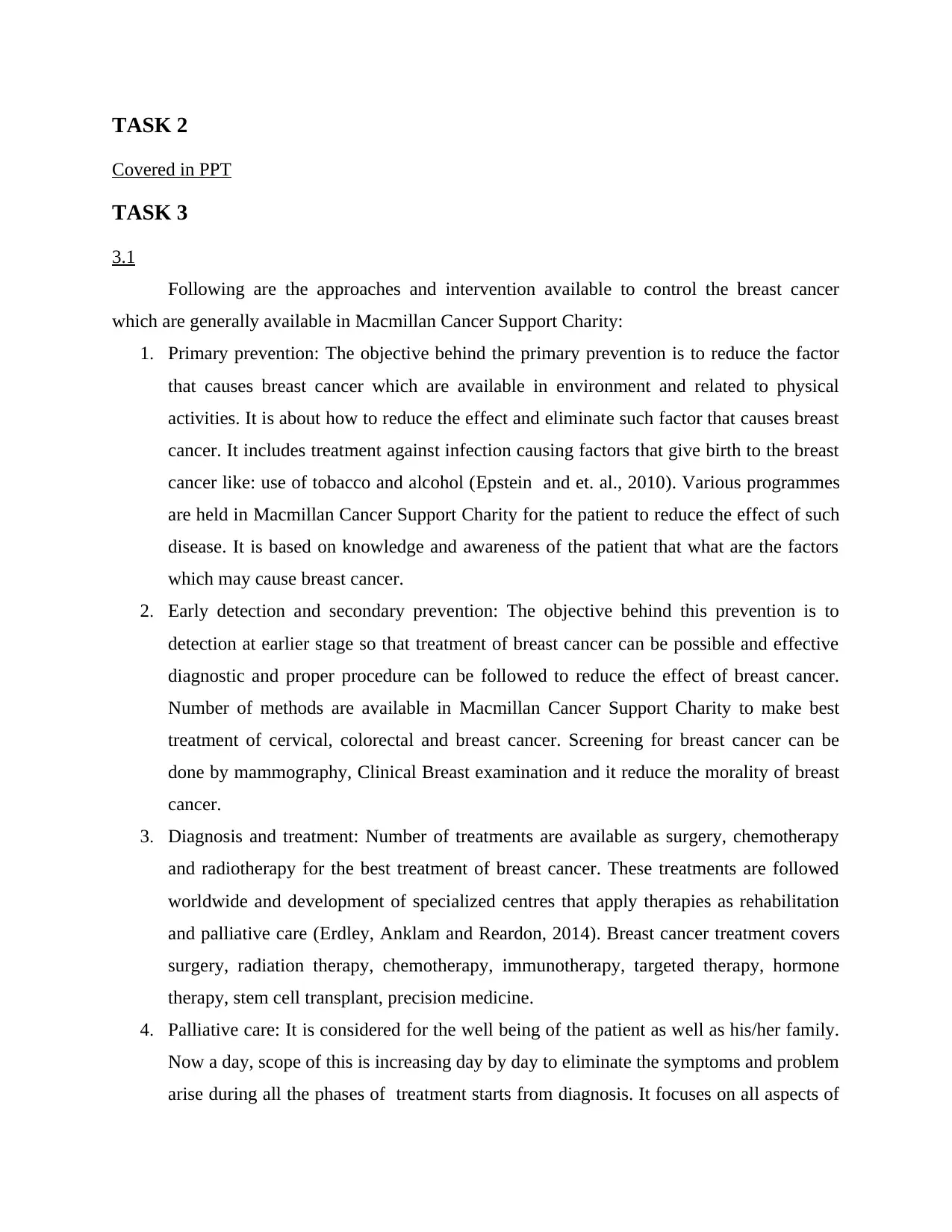
TASK 2
Covered in PPT
TASK 3
3.1
Following are the approaches and intervention available to control the breast cancer
which are generally available in Macmillan Cancer Support Charity:
1. Primary prevention: The objective behind the primary prevention is to reduce the factor
that causes breast cancer which are available in environment and related to physical
activities. It is about how to reduce the effect and eliminate such factor that causes breast
cancer. It includes treatment against infection causing factors that give birth to the breast
cancer like: use of tobacco and alcohol (Epstein and et. al., 2010). Various programmes
are held in Macmillan Cancer Support Charity for the patient to reduce the effect of such
disease. It is based on knowledge and awareness of the patient that what are the factors
which may cause breast cancer.
2. Early detection and secondary prevention: The objective behind this prevention is to
detection at earlier stage so that treatment of breast cancer can be possible and effective
diagnostic and proper procedure can be followed to reduce the effect of breast cancer.
Number of methods are available in Macmillan Cancer Support Charity to make best
treatment of cervical, colorectal and breast cancer. Screening for breast cancer can be
done by mammography, Clinical Breast examination and it reduce the morality of breast
cancer.
3. Diagnosis and treatment: Number of treatments are available as surgery, chemotherapy
and radiotherapy for the best treatment of breast cancer. These treatments are followed
worldwide and development of specialized centres that apply therapies as rehabilitation
and palliative care (Erdley, Anklam and Reardon, 2014). Breast cancer treatment covers
surgery, radiation therapy, chemotherapy, immunotherapy, targeted therapy, hormone
therapy, stem cell transplant, precision medicine.
4. Palliative care: It is considered for the well being of the patient as well as his/her family.
Now a day, scope of this is increasing day by day to eliminate the symptoms and problem
arise during all the phases of treatment starts from diagnosis. It focuses on all aspects of
Covered in PPT
TASK 3
3.1
Following are the approaches and intervention available to control the breast cancer
which are generally available in Macmillan Cancer Support Charity:
1. Primary prevention: The objective behind the primary prevention is to reduce the factor
that causes breast cancer which are available in environment and related to physical
activities. It is about how to reduce the effect and eliminate such factor that causes breast
cancer. It includes treatment against infection causing factors that give birth to the breast
cancer like: use of tobacco and alcohol (Epstein and et. al., 2010). Various programmes
are held in Macmillan Cancer Support Charity for the patient to reduce the effect of such
disease. It is based on knowledge and awareness of the patient that what are the factors
which may cause breast cancer.
2. Early detection and secondary prevention: The objective behind this prevention is to
detection at earlier stage so that treatment of breast cancer can be possible and effective
diagnostic and proper procedure can be followed to reduce the effect of breast cancer.
Number of methods are available in Macmillan Cancer Support Charity to make best
treatment of cervical, colorectal and breast cancer. Screening for breast cancer can be
done by mammography, Clinical Breast examination and it reduce the morality of breast
cancer.
3. Diagnosis and treatment: Number of treatments are available as surgery, chemotherapy
and radiotherapy for the best treatment of breast cancer. These treatments are followed
worldwide and development of specialized centres that apply therapies as rehabilitation
and palliative care (Erdley, Anklam and Reardon, 2014). Breast cancer treatment covers
surgery, radiation therapy, chemotherapy, immunotherapy, targeted therapy, hormone
therapy, stem cell transplant, precision medicine.
4. Palliative care: It is considered for the well being of the patient as well as his/her family.
Now a day, scope of this is increasing day by day to eliminate the symptoms and problem
arise during all the phases of treatment starts from diagnosis. It focuses on all aspects of
⊘ This is a preview!⊘
Do you want full access?
Subscribe today to unlock all pages.

Trusted by 1+ million students worldwide
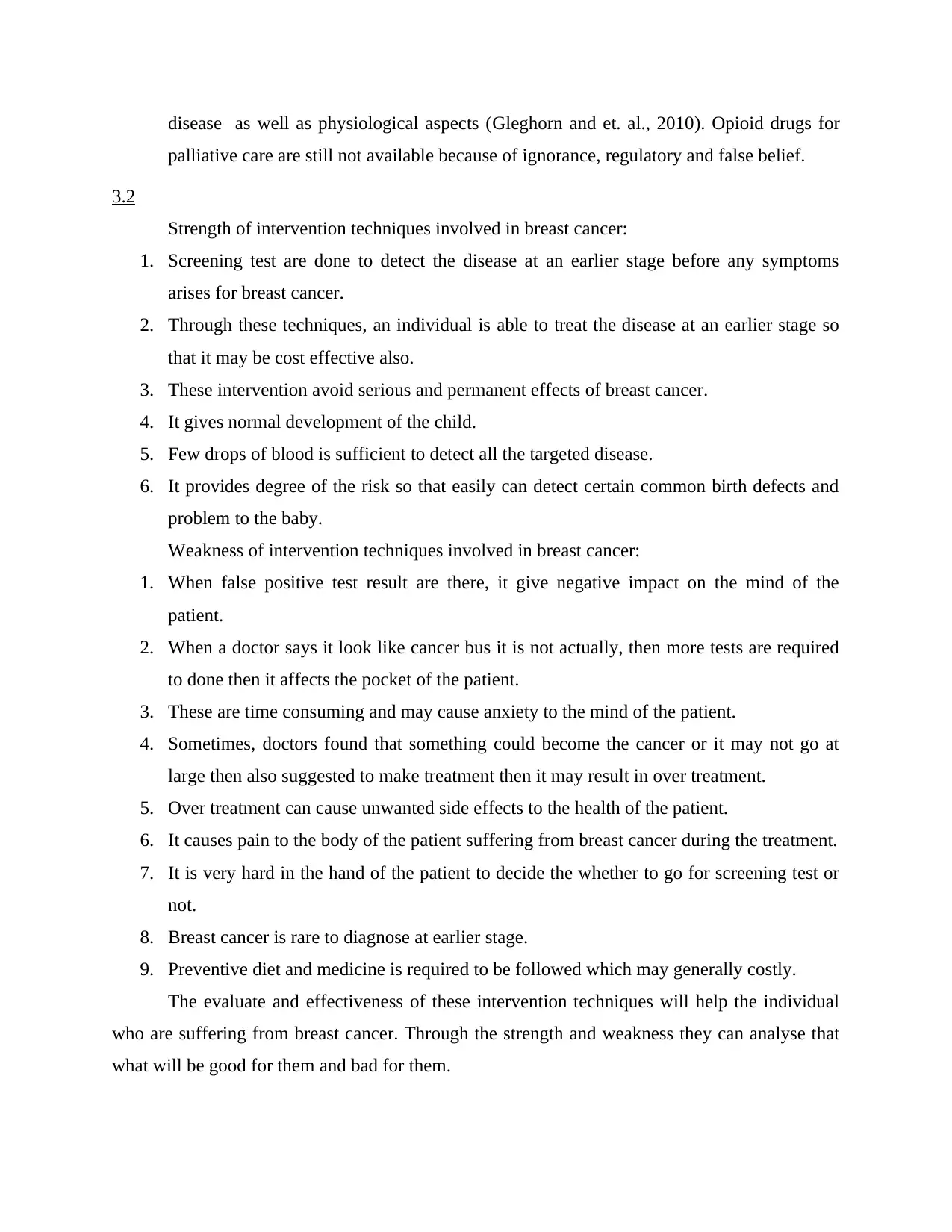
disease as well as physiological aspects (Gleghorn and et. al., 2010). Opioid drugs for
palliative care are still not available because of ignorance, regulatory and false belief.
3.2
Strength of intervention techniques involved in breast cancer:
1. Screening test are done to detect the disease at an earlier stage before any symptoms
arises for breast cancer.
2. Through these techniques, an individual is able to treat the disease at an earlier stage so
that it may be cost effective also.
3. These intervention avoid serious and permanent effects of breast cancer.
4. It gives normal development of the child.
5. Few drops of blood is sufficient to detect all the targeted disease.
6. It provides degree of the risk so that easily can detect certain common birth defects and
problem to the baby.
Weakness of intervention techniques involved in breast cancer:
1. When false positive test result are there, it give negative impact on the mind of the
patient.
2. When a doctor says it look like cancer bus it is not actually, then more tests are required
to done then it affects the pocket of the patient.
3. These are time consuming and may cause anxiety to the mind of the patient.
4. Sometimes, doctors found that something could become the cancer or it may not go at
large then also suggested to make treatment then it may result in over treatment.
5. Over treatment can cause unwanted side effects to the health of the patient.
6. It causes pain to the body of the patient suffering from breast cancer during the treatment.
7. It is very hard in the hand of the patient to decide the whether to go for screening test or
not.
8. Breast cancer is rare to diagnose at earlier stage.
9. Preventive diet and medicine is required to be followed which may generally costly.
The evaluate and effectiveness of these intervention techniques will help the individual
who are suffering from breast cancer. Through the strength and weakness they can analyse that
what will be good for them and bad for them.
palliative care are still not available because of ignorance, regulatory and false belief.
3.2
Strength of intervention techniques involved in breast cancer:
1. Screening test are done to detect the disease at an earlier stage before any symptoms
arises for breast cancer.
2. Through these techniques, an individual is able to treat the disease at an earlier stage so
that it may be cost effective also.
3. These intervention avoid serious and permanent effects of breast cancer.
4. It gives normal development of the child.
5. Few drops of blood is sufficient to detect all the targeted disease.
6. It provides degree of the risk so that easily can detect certain common birth defects and
problem to the baby.
Weakness of intervention techniques involved in breast cancer:
1. When false positive test result are there, it give negative impact on the mind of the
patient.
2. When a doctor says it look like cancer bus it is not actually, then more tests are required
to done then it affects the pocket of the patient.
3. These are time consuming and may cause anxiety to the mind of the patient.
4. Sometimes, doctors found that something could become the cancer or it may not go at
large then also suggested to make treatment then it may result in over treatment.
5. Over treatment can cause unwanted side effects to the health of the patient.
6. It causes pain to the body of the patient suffering from breast cancer during the treatment.
7. It is very hard in the hand of the patient to decide the whether to go for screening test or
not.
8. Breast cancer is rare to diagnose at earlier stage.
9. Preventive diet and medicine is required to be followed which may generally costly.
The evaluate and effectiveness of these intervention techniques will help the individual
who are suffering from breast cancer. Through the strength and weakness they can analyse that
what will be good for them and bad for them.
Paraphrase This Document
Need a fresh take? Get an instant paraphrase of this document with our AI Paraphraser
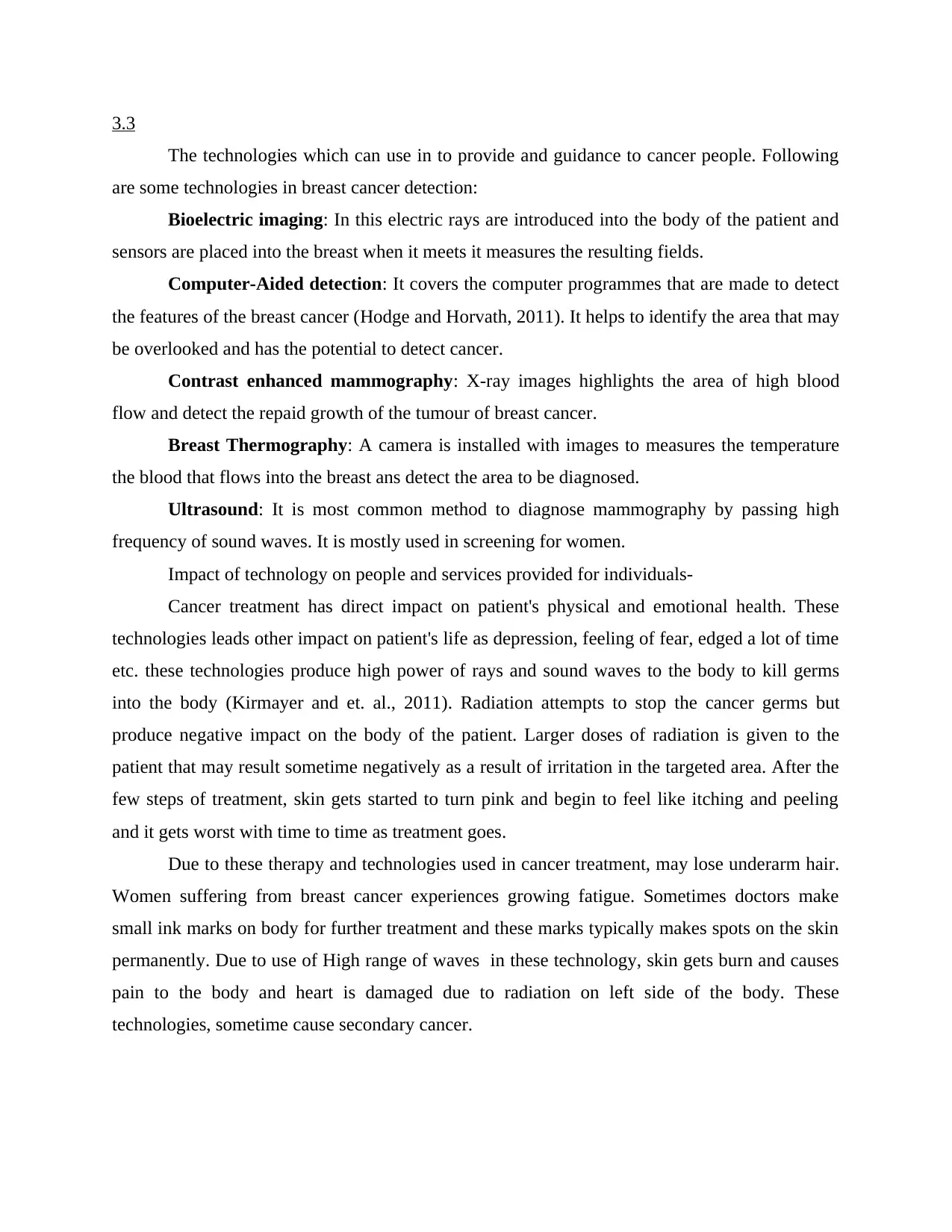
3.3
The technologies which can use in to provide and guidance to cancer people. Following
are some technologies in breast cancer detection:
Bioelectric imaging: In this electric rays are introduced into the body of the patient and
sensors are placed into the breast when it meets it measures the resulting fields.
Computer-Aided detection: It covers the computer programmes that are made to detect
the features of the breast cancer (Hodge and Horvath, 2011). It helps to identify the area that may
be overlooked and has the potential to detect cancer.
Contrast enhanced mammography: X-ray images highlights the area of high blood
flow and detect the repaid growth of the tumour of breast cancer.
Breast Thermography: A camera is installed with images to measures the temperature
the blood that flows into the breast ans detect the area to be diagnosed.
Ultrasound: It is most common method to diagnose mammography by passing high
frequency of sound waves. It is mostly used in screening for women.
Impact of technology on people and services provided for individuals-
Cancer treatment has direct impact on patient's physical and emotional health. These
technologies leads other impact on patient's life as depression, feeling of fear, edged a lot of time
etc. these technologies produce high power of rays and sound waves to the body to kill germs
into the body (Kirmayer and et. al., 2011). Radiation attempts to stop the cancer germs but
produce negative impact on the body of the patient. Larger doses of radiation is given to the
patient that may result sometime negatively as a result of irritation in the targeted area. After the
few steps of treatment, skin gets started to turn pink and begin to feel like itching and peeling
and it gets worst with time to time as treatment goes.
Due to these therapy and technologies used in cancer treatment, may lose underarm hair.
Women suffering from breast cancer experiences growing fatigue. Sometimes doctors make
small ink marks on body for further treatment and these marks typically makes spots on the skin
permanently. Due to use of High range of waves in these technology, skin gets burn and causes
pain to the body and heart is damaged due to radiation on left side of the body. These
technologies, sometime cause secondary cancer.
The technologies which can use in to provide and guidance to cancer people. Following
are some technologies in breast cancer detection:
Bioelectric imaging: In this electric rays are introduced into the body of the patient and
sensors are placed into the breast when it meets it measures the resulting fields.
Computer-Aided detection: It covers the computer programmes that are made to detect
the features of the breast cancer (Hodge and Horvath, 2011). It helps to identify the area that may
be overlooked and has the potential to detect cancer.
Contrast enhanced mammography: X-ray images highlights the area of high blood
flow and detect the repaid growth of the tumour of breast cancer.
Breast Thermography: A camera is installed with images to measures the temperature
the blood that flows into the breast ans detect the area to be diagnosed.
Ultrasound: It is most common method to diagnose mammography by passing high
frequency of sound waves. It is mostly used in screening for women.
Impact of technology on people and services provided for individuals-
Cancer treatment has direct impact on patient's physical and emotional health. These
technologies leads other impact on patient's life as depression, feeling of fear, edged a lot of time
etc. these technologies produce high power of rays and sound waves to the body to kill germs
into the body (Kirmayer and et. al., 2011). Radiation attempts to stop the cancer germs but
produce negative impact on the body of the patient. Larger doses of radiation is given to the
patient that may result sometime negatively as a result of irritation in the targeted area. After the
few steps of treatment, skin gets started to turn pink and begin to feel like itching and peeling
and it gets worst with time to time as treatment goes.
Due to these therapy and technologies used in cancer treatment, may lose underarm hair.
Women suffering from breast cancer experiences growing fatigue. Sometimes doctors make
small ink marks on body for further treatment and these marks typically makes spots on the skin
permanently. Due to use of High range of waves in these technology, skin gets burn and causes
pain to the body and heart is damaged due to radiation on left side of the body. These
technologies, sometime cause secondary cancer.
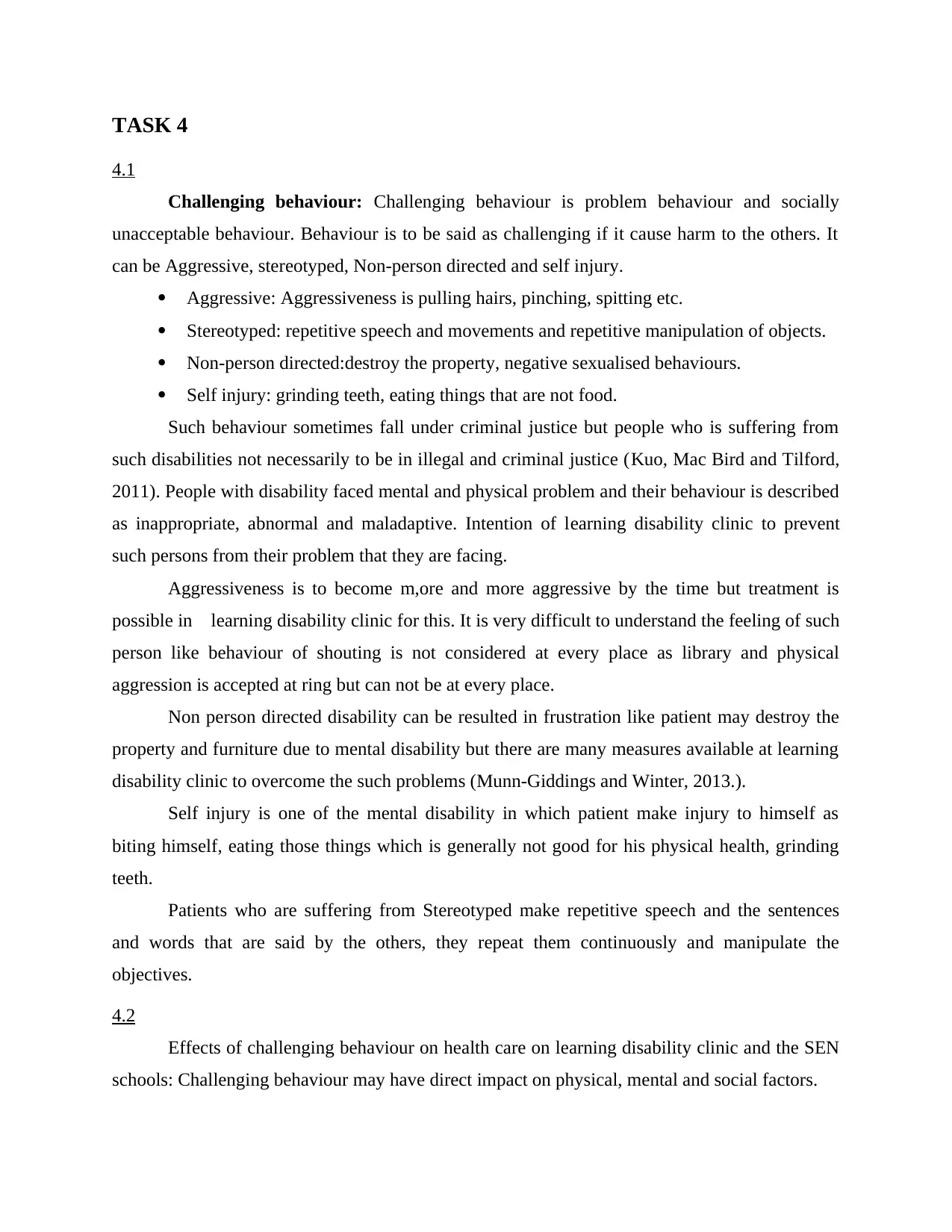
TASK 4
4.1
Challenging behaviour: Challenging behaviour is problem behaviour and socially
unacceptable behaviour. Behaviour is to be said as challenging if it cause harm to the others. It
can be Aggressive, stereotyped, Non-person directed and self injury.
Aggressive: Aggressiveness is pulling hairs, pinching, spitting etc.
Stereotyped: repetitive speech and movements and repetitive manipulation of objects.
Non-person directed:destroy the property, negative sexualised behaviours.
Self injury: grinding teeth, eating things that are not food.
Such behaviour sometimes fall under criminal justice but people who is suffering from
such disabilities not necessarily to be in illegal and criminal justice (Kuo, Mac Bird and Tilford,
2011). People with disability faced mental and physical problem and their behaviour is described
as inappropriate, abnormal and maladaptive. Intention of learning disability clinic to prevent
such persons from their problem that they are facing.
Aggressiveness is to become m,ore and more aggressive by the time but treatment is
possible in learning disability clinic for this. It is very difficult to understand the feeling of such
person like behaviour of shouting is not considered at every place as library and physical
aggression is accepted at ring but can not be at every place.
Non person directed disability can be resulted in frustration like patient may destroy the
property and furniture due to mental disability but there are many measures available at learning
disability clinic to overcome the such problems (Munn-Giddings and Winter, 2013.).
Self injury is one of the mental disability in which patient make injury to himself as
biting himself, eating those things which is generally not good for his physical health, grinding
teeth.
Patients who are suffering from Stereotyped make repetitive speech and the sentences
and words that are said by the others, they repeat them continuously and manipulate the
objectives.
4.2
Effects of challenging behaviour on health care on learning disability clinic and the SEN
schools: Challenging behaviour may have direct impact on physical, mental and social factors.
4.1
Challenging behaviour: Challenging behaviour is problem behaviour and socially
unacceptable behaviour. Behaviour is to be said as challenging if it cause harm to the others. It
can be Aggressive, stereotyped, Non-person directed and self injury.
Aggressive: Aggressiveness is pulling hairs, pinching, spitting etc.
Stereotyped: repetitive speech and movements and repetitive manipulation of objects.
Non-person directed:destroy the property, negative sexualised behaviours.
Self injury: grinding teeth, eating things that are not food.
Such behaviour sometimes fall under criminal justice but people who is suffering from
such disabilities not necessarily to be in illegal and criminal justice (Kuo, Mac Bird and Tilford,
2011). People with disability faced mental and physical problem and their behaviour is described
as inappropriate, abnormal and maladaptive. Intention of learning disability clinic to prevent
such persons from their problem that they are facing.
Aggressiveness is to become m,ore and more aggressive by the time but treatment is
possible in learning disability clinic for this. It is very difficult to understand the feeling of such
person like behaviour of shouting is not considered at every place as library and physical
aggression is accepted at ring but can not be at every place.
Non person directed disability can be resulted in frustration like patient may destroy the
property and furniture due to mental disability but there are many measures available at learning
disability clinic to overcome the such problems (Munn-Giddings and Winter, 2013.).
Self injury is one of the mental disability in which patient make injury to himself as
biting himself, eating those things which is generally not good for his physical health, grinding
teeth.
Patients who are suffering from Stereotyped make repetitive speech and the sentences
and words that are said by the others, they repeat them continuously and manipulate the
objectives.
4.2
Effects of challenging behaviour on health care on learning disability clinic and the SEN
schools: Challenging behaviour may have direct impact on physical, mental and social factors.
⊘ This is a preview!⊘
Do you want full access?
Subscribe today to unlock all pages.

Trusted by 1+ million students worldwide
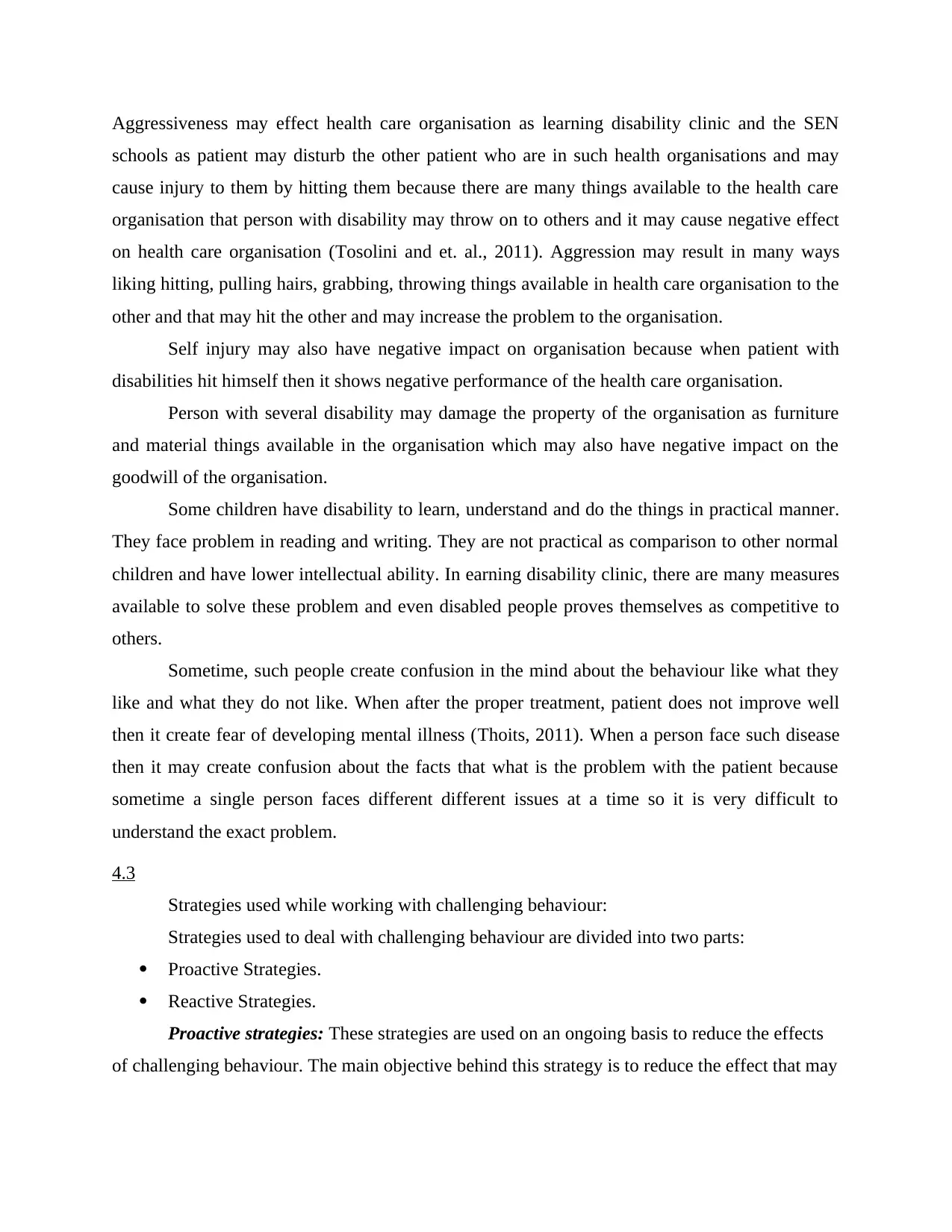
Aggressiveness may effect health care organisation as learning disability clinic and the SEN
schools as patient may disturb the other patient who are in such health organisations and may
cause injury to them by hitting them because there are many things available to the health care
organisation that person with disability may throw on to others and it may cause negative effect
on health care organisation (Tosolini and et. al., 2011). Aggression may result in many ways
liking hitting, pulling hairs, grabbing, throwing things available in health care organisation to the
other and that may hit the other and may increase the problem to the organisation.
Self injury may also have negative impact on organisation because when patient with
disabilities hit himself then it shows negative performance of the health care organisation.
Person with several disability may damage the property of the organisation as furniture
and material things available in the organisation which may also have negative impact on the
goodwill of the organisation.
Some children have disability to learn, understand and do the things in practical manner.
They face problem in reading and writing. They are not practical as comparison to other normal
children and have lower intellectual ability. In earning disability clinic, there are many measures
available to solve these problem and even disabled people proves themselves as competitive to
others.
Sometime, such people create confusion in the mind about the behaviour like what they
like and what they do not like. When after the proper treatment, patient does not improve well
then it create fear of developing mental illness (Thoits, 2011). When a person face such disease
then it may create confusion about the facts that what is the problem with the patient because
sometime a single person faces different different issues at a time so it is very difficult to
understand the exact problem.
4.3
Strategies used while working with challenging behaviour:
Strategies used to deal with challenging behaviour are divided into two parts:
Proactive Strategies.
Reactive Strategies.
Proactive strategies: These strategies are used on an ongoing basis to reduce the effects
of challenging behaviour. The main objective behind this strategy is to reduce the effect that may
schools as patient may disturb the other patient who are in such health organisations and may
cause injury to them by hitting them because there are many things available to the health care
organisation that person with disability may throw on to others and it may cause negative effect
on health care organisation (Tosolini and et. al., 2011). Aggression may result in many ways
liking hitting, pulling hairs, grabbing, throwing things available in health care organisation to the
other and that may hit the other and may increase the problem to the organisation.
Self injury may also have negative impact on organisation because when patient with
disabilities hit himself then it shows negative performance of the health care organisation.
Person with several disability may damage the property of the organisation as furniture
and material things available in the organisation which may also have negative impact on the
goodwill of the organisation.
Some children have disability to learn, understand and do the things in practical manner.
They face problem in reading and writing. They are not practical as comparison to other normal
children and have lower intellectual ability. In earning disability clinic, there are many measures
available to solve these problem and even disabled people proves themselves as competitive to
others.
Sometime, such people create confusion in the mind about the behaviour like what they
like and what they do not like. When after the proper treatment, patient does not improve well
then it create fear of developing mental illness (Thoits, 2011). When a person face such disease
then it may create confusion about the facts that what is the problem with the patient because
sometime a single person faces different different issues at a time so it is very difficult to
understand the exact problem.
4.3
Strategies used while working with challenging behaviour:
Strategies used to deal with challenging behaviour are divided into two parts:
Proactive Strategies.
Reactive Strategies.
Proactive strategies: These strategies are used on an ongoing basis to reduce the effects
of challenging behaviour. The main objective behind this strategy is to reduce the effect that may
Paraphrase This Document
Need a fresh take? Get an instant paraphrase of this document with our AI Paraphraser
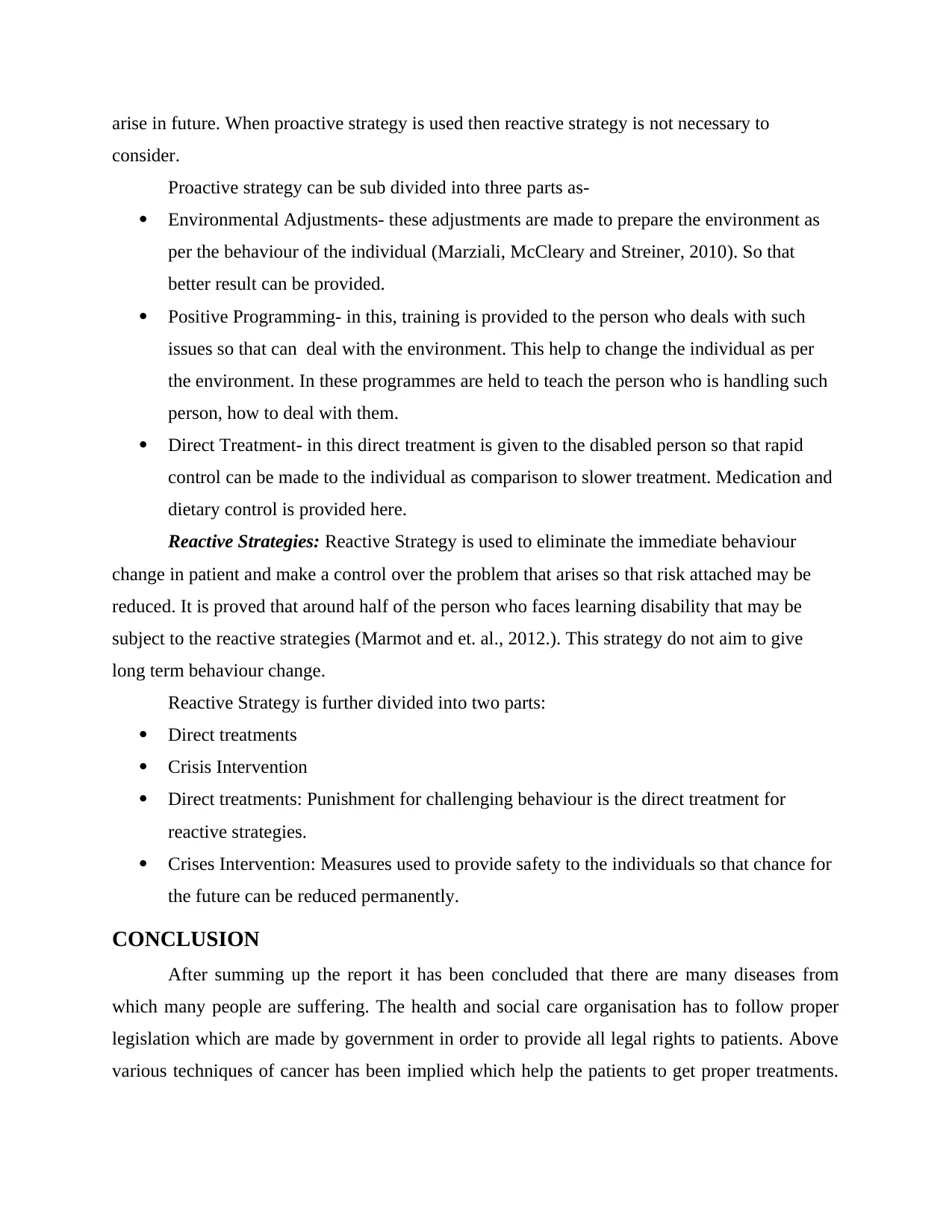
arise in future. When proactive strategy is used then reactive strategy is not necessary to
consider.
Proactive strategy can be sub divided into three parts as-
Environmental Adjustments- these adjustments are made to prepare the environment as
per the behaviour of the individual (Marziali, McCleary and Streiner, 2010). So that
better result can be provided.
Positive Programming- in this, training is provided to the person who deals with such
issues so that can deal with the environment. This help to change the individual as per
the environment. In these programmes are held to teach the person who is handling such
person, how to deal with them.
Direct Treatment- in this direct treatment is given to the disabled person so that rapid
control can be made to the individual as comparison to slower treatment. Medication and
dietary control is provided here.
Reactive Strategies: Reactive Strategy is used to eliminate the immediate behaviour
change in patient and make a control over the problem that arises so that risk attached may be
reduced. It is proved that around half of the person who faces learning disability that may be
subject to the reactive strategies (Marmot and et. al., 2012.). This strategy do not aim to give
long term behaviour change.
Reactive Strategy is further divided into two parts:
Direct treatments
Crisis Intervention
Direct treatments: Punishment for challenging behaviour is the direct treatment for
reactive strategies.
Crises Intervention: Measures used to provide safety to the individuals so that chance for
the future can be reduced permanently.
CONCLUSION
After summing up the report it has been concluded that there are many diseases from
which many people are suffering. The health and social care organisation has to follow proper
legislation which are made by government in order to provide all legal rights to patients. Above
various techniques of cancer has been implied which help the patients to get proper treatments.
consider.
Proactive strategy can be sub divided into three parts as-
Environmental Adjustments- these adjustments are made to prepare the environment as
per the behaviour of the individual (Marziali, McCleary and Streiner, 2010). So that
better result can be provided.
Positive Programming- in this, training is provided to the person who deals with such
issues so that can deal with the environment. This help to change the individual as per
the environment. In these programmes are held to teach the person who is handling such
person, how to deal with them.
Direct Treatment- in this direct treatment is given to the disabled person so that rapid
control can be made to the individual as comparison to slower treatment. Medication and
dietary control is provided here.
Reactive Strategies: Reactive Strategy is used to eliminate the immediate behaviour
change in patient and make a control over the problem that arises so that risk attached may be
reduced. It is proved that around half of the person who faces learning disability that may be
subject to the reactive strategies (Marmot and et. al., 2012.). This strategy do not aim to give
long term behaviour change.
Reactive Strategy is further divided into two parts:
Direct treatments
Crisis Intervention
Direct treatments: Punishment for challenging behaviour is the direct treatment for
reactive strategies.
Crises Intervention: Measures used to provide safety to the individuals so that chance for
the future can be reduced permanently.
CONCLUSION
After summing up the report it has been concluded that there are many diseases from
which many people are suffering. The health and social care organisation has to follow proper
legislation which are made by government in order to provide all legal rights to patients. Above
various techniques of cancer has been implied which help the patients to get proper treatments.
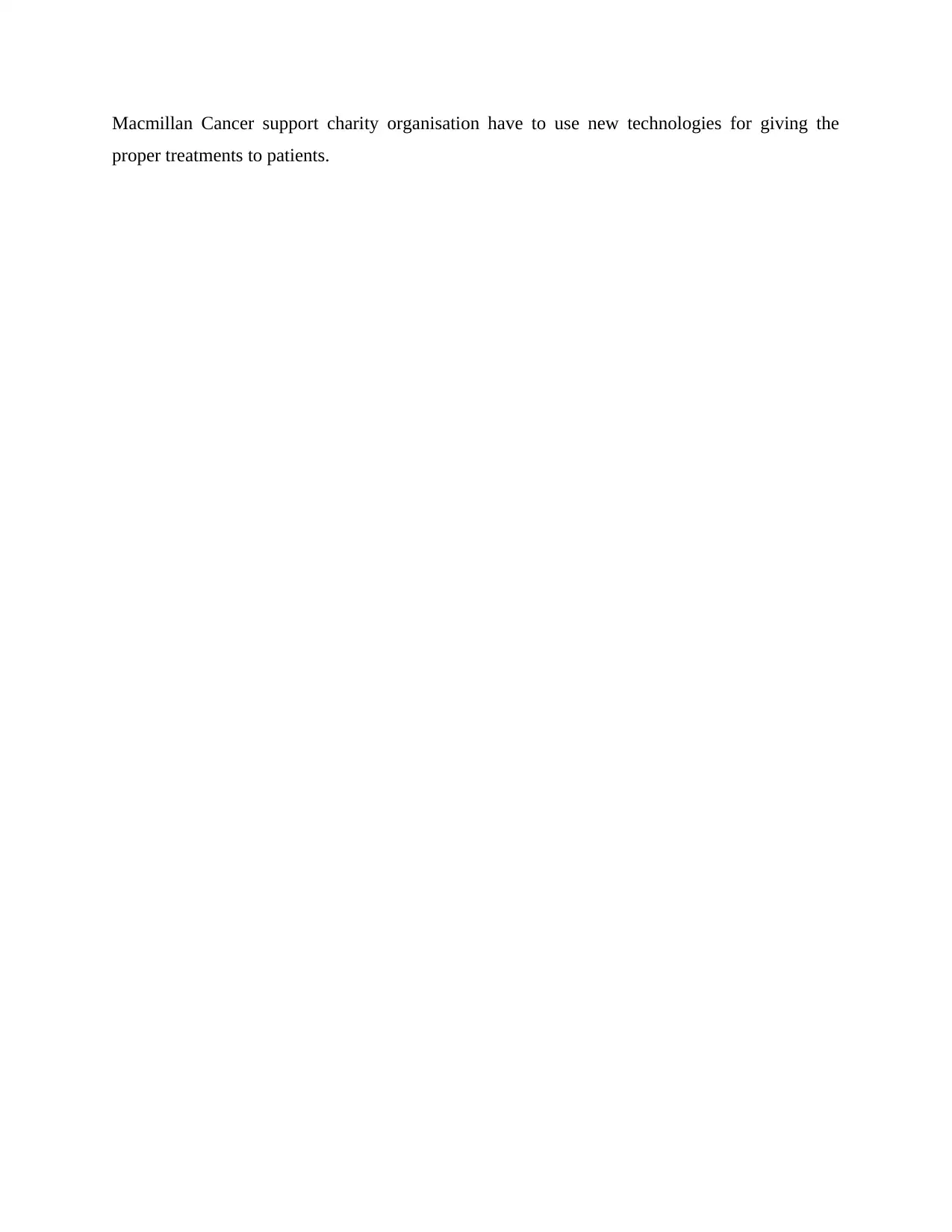
Macmillan Cancer support charity organisation have to use new technologies for giving the
proper treatments to patients.
proper treatments to patients.
⊘ This is a preview!⊘
Do you want full access?
Subscribe today to unlock all pages.

Trusted by 1+ million students worldwide
1 out of 14
Related Documents
Your All-in-One AI-Powered Toolkit for Academic Success.
+13062052269
info@desklib.com
Available 24*7 on WhatsApp / Email
![[object Object]](/_next/static/media/star-bottom.7253800d.svg)
Unlock your academic potential
Copyright © 2020–2025 A2Z Services. All Rights Reserved. Developed and managed by ZUCOL.

